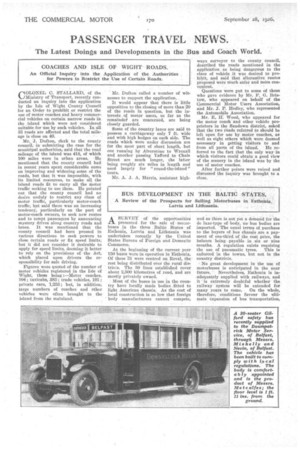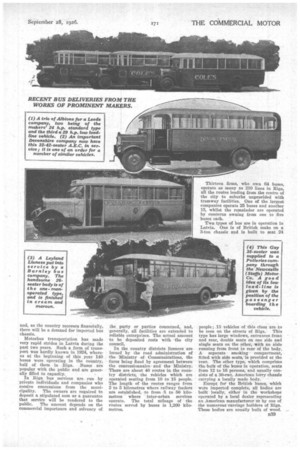BUS DEVELOPMENT . IN THE BALTIC STATES.
Page 56

Page 57

Page 58

If you've noticed an error in this article please click here to report it so we can fix it.
A Review of the Prospects for Selling Motorbuses in 'Esthonia,•
Latvia arid Lithuania. .
A SURVEY of the opportunities 211. presented for the sale of motorbuses in in the three Sallie States of Esthonia, Latvia and Lithuania was undertaken recently by the United States Bureau of Foreign and Domestic Commerce.
At the beginning of the current year 150 buses were in operation in Esthonia. Of these '31 were centred on Revd, the rest being distributed over the rural districzs. The 50 lines established cover about 2,500 kilometres of road, and are
mostly privately owned. .
Most of the buses in use in the country have locally made bodies fitted to light American chassis. As the cost of local construction is so low that foreign body manufacturers cannot compete, and as there is not yet a demand for the de luxe-type of•body, no bus bodies are imported. 'The usual terms of purchase to the buyers of bus chassis are a payment of one-third, of the cost price, the balance "being payable in six or nine months. A regulation exists requiring the use of pneumatic tyres. This is enforced in the towns, but not in the country districts.
No great development in the use of motorbuses is anticipated in the near
future. Nevertheless, Esthonia is inadequately supplied with railways, and it is extremely doubtful whether the railway system will be extended for many years to come. On the whole, therefore, conditions favour the ultimate expansion of bus transportation,
and, as the country recovers financially, there will be a demand for imported bus chassis.
Motorbus transportation has made very rapid strides in Latvia during the past two years. Such a form of transport was hardly known in 1924, whereas at the beginning of this year 140 buses were operating in the country, half of them in Riga. Buses are popular with the public and are generally filled to capacity.
In Riga bus services are run by private individuals and companies who receive concessions from the municipality. The owners are required to deposit a stipulated sum as a guarantee that service will be rendered to the public. The amount depends on the commercial importance and solvency of the party or parties concerned, and, generally, all facilities are extended to reliable enterprises. The actual amount to be deposited rests with the city council.
In the country districts licences are issued by the road administration of the Ministry of Communications, the fares being fixed by agreement between the concessionnaire and the Ministry. There are about 40 routes in the country districts, the Vehicles which are operated seating from 10 to 15 people. The length of the routes ranges from 3 to 5 kilometres where railway feeders are established, to from 5 to 50 kilometres where inter-urban services operate. The total mileage of the routes served by buses is 1,200 kilometres. Thirteen firms, who own 64 buses, operate as many as 210 lines in Riga, all the routes leading from the centre of the city to suburbs unprovided with tramway facilities. One of the largest companies operate 25 buses and another 15, whilst the remainder are operated by concerns owning from one to five buses each.
Two types of bus are in operation in Latvia. One is of British make on a 3-ton chassis and is built to seat 24 people; 13 vehicles of this class are to be seen on the streets of Riga. This type has large windows, entrances front and rear, double seats on one side and single seats on the other, with an aisle running from front to rear of the body. A separate smoking compartment, fitted with side seats, is provided at the rear. The other type, which comprises the bulk of the buses in operation, seats from 12 to 16 persons, and usually consists of a 30-cwt American lorry chassis carrying a locally made body.
Except for the British buses, which were imported complete, all bodies are built locally, either in the workshops operated by a local dealer representing an American manufacturer or by one of the numerous carriage builders of Riga. These bodies are usually built of wood. plywood or sheet-iron, have glass windows all around and an entrance from the rear. Ninety per cent, of the light bus chassis imported into the country come from America.
Motorbus developments in Latvia are retarded by poor road conditions mid a comparatively high duty on petrol. Local authorities, however, adopt a favourable attitude with regard to the use of buses, and every effort is being made to improve the Country roads. Moreover, the number of small towns between which there is no rail or bus communication is still very large, whilst there are towns such as Libau, Windau, Dvinsk, Walk and a few others where buses could be operated successfully. Another point in favour of the bus is that it is considered unlikely that existing railway and other communications will, in the near future, be extended materially.
The general conditions affecting bus transportation in Esthonia and Latvia also apply to Lithuania, where, however, little progress has been made, it is estimated that 21 buses were in operation in January this year, and nearly all of these were running in Kovno. An extension of this service may be expected in the country districts, but adverse economic conditions are militating factors against development.




































































































